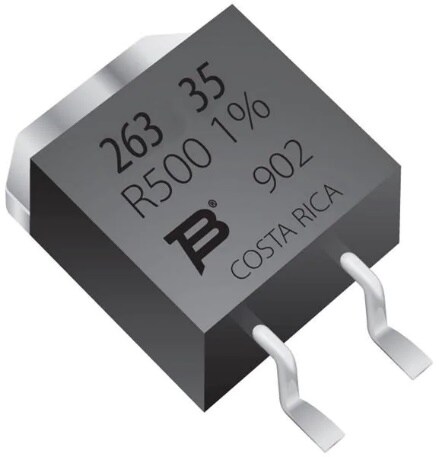Limiting Voltages

Image Source: Oasishifi/Shutterstock.com
By Marcel Consée, Mouser Electronics
Published October 8, 2021
Each resistor’s purpose is to lay obstacles in the way of electrons passing through them. This is, so the designer has control over the currents and voltages running through the circuit. There are different ways to do that. Traditional carbon resistors, for example, make use of differently-sized particles pressed to varying densities. This method has large manufacturing tolerances and induces high noise levels into electronic circuits.
Carbon composition resistors and metal foil resistors have much better noise levels and smaller tolerances. Due to their temperature stability and precision, metal foil resistors are the products of choice in today’s electrical and electronic engineering.
Symbols, Colors, and the E-Series
There are two circuit symbols for resistors. Like the preference for imperial units, the US prefers a zigzag line (Figure 1b), while the rest of the world has standardized on the rectangle as the resistor symbol (Figure 1a). However, there is only one colour code (Figure 1c) that indicates the Ohm value with coloured rings on conventional resistors. There can be three, four, five, or six rings, indicating (from left to right): Value, multiplier, tolerance, and temperature coefficients. Mouser’s Colour Code Calculator helps to decipher the rings.



Figure 1: (a) IEC symbol, (b) ANSI symbol, (c) example of colour rings. (Source: Mouser.com)
SMD resistors show the values more directly but still not very intuitively. For example, the letter “R” stands for Ohm, but also stands for decimal point (examples: 7R50 = 7.5Ω; R500 = 0.5Ω Then there are the orders of magnitude: “10k” are “10kΩ”, “1M5” are “1.5MΩ” and “0k5” “0.5kΩ”.

Figure 2: SMD resistor with 0.5Ω markings. (Source: Mouser.com)
To ensure you are using the correct resistor, it helps to measure the device using a handheld instrument like an Ohmmeter or a Multimeter.
Since it doesn’t make sense to manufacture resistors of every possible value, the industry invented the ‘E-Series’ of standardized values for resistors, capacitors, inductors, and Zener diodes. These values can be combined to create virtually any required value while minimizing the number of manufactured and stocked values. E-series resistors follow a mathematical formula determined by the n-th root:

where Vn is the rounded value, m is an integer of the E series group size, and n is an integer of {0, 1, 2, ..., m-1}. Manufacturers use E-series tables to provide resistors with standardized values and precision.
Logic combinations
When faced with a design that requires a particular resistance value that’s not readily available, there are various options for reaching this value. One method is to use a trim potentiometer that allows the user to adjust the resistance.
Another method is a series connection. Connecting resistors in a series, the total resistance is the sum of the individual resistance values. This is also the principle of the voltage divider, as used in multimeters.
Connecting resistors in parallel leads to a total resistance smaller than the smallest individual resistor. The total resistance follows the function:
Light and Heat
Light-dependent resistors (Photoresistors) provide variable resistance. They are not as sensitive as phototransistors or photodiodes, but they are suitable for applications like analogue light dimmers. Their resistance is reciprocally proportional to the light intensity.
Temperature-dependent resistors (Thermistors) are another kind of resistor with variable resistance. They can be of the NTC type (negative temperature coefficient) or the PTC type (positive TC). The resistance of a PTC thermistor is proportional to the temperature, while it is reciprocal with NTCs. Both types are commonly used as temperature sensors.
Conclusion
There is a wide variety of resistor types, and it should be easy to find the right one for each electronic design. While the historic conventions regarding denomination and marking may be hard to understand, many online tools are available that simplify the selection.